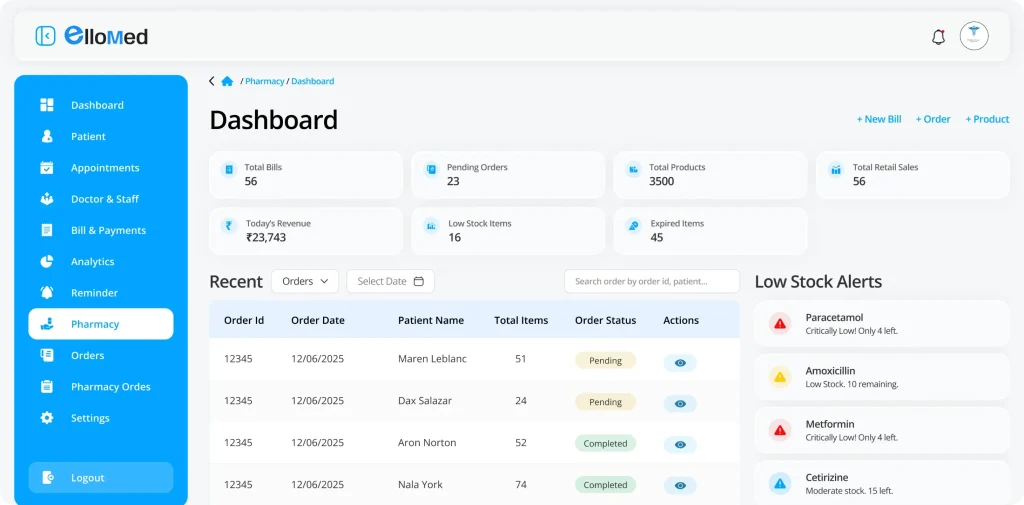Pros and Cons of Custom Web Design vs. Template Web Design

The decision between a template and a custom web design is based on your budget, schedule, and business objectives. Custom web designs are tailored to your brand, offering enhanced scalability, security, and long-term growth flexibility. In contrast, templates enable rapid, low-cost launches with basic features.
Template Web Design:
Pros:
- Budget-Friendly: Templates are affordable, particularly for new and small enterprises. You don’t have to spend a lot of money on design and development to launch a respectable-looking website.
- Ready to Launch: Just add content and make minor adjustments before launching the templates. They are therefore perfect for companies seeking a rapid online presence.
- Requires Minimal IT Help: You can avoid hiring developers by using drag-and-drop builders and easy customization tools, which allow anyone with rudimentary computer skills to set up a website.
- Reliable Updates: To keep your website operating smoothly, designers frequently update templates to stay compatible with the newest web standards and technologies.
- Wide Range of Options: Whether you’re a blogger, restaurant owner, or retailer, there’s probably a theme that will work for you among the hundreds of themes available for various industries.
- User-Friendly Plugins: The majority of templates allow for the addition of practical features without knowing any code, thanks to support for well-known plugins like image sliders, social media feeds, and contact forms.
- Third-Party App Integration: To help you manage your business efficiently, templates typically offer built-in integration with necessary apps like analytics, email marketing tools, and payment gateways.
- Clear Structural Layout: Templates offer an organized framework that makes it simpler to edit and arrange your content by assisting you in visualizing how your website will appear.

Cons:
- Lack of Uniqueness: Your website may resemble that of others, as numerous companies utilize the same templates, thereby making it difficult to distinguish oneself in a competitive market.
- Limited Customization: If the template has locked features, you might not be able to modify certain components, such as layout or functionality, to meet your precise requirements.
- Limited Functionality: You might not be able to provide distinctive user experiences if you don’t support advanced features like product filtering or custom booking systems.
- Security Issues: Many templates rely on third-party plugins that may not receive regular updates, which can leave your website vulnerable to malware or hacking attempts.
- Not Always Friendly to SEO: Some templates contain poorly organized or bloated code, which can lower the visibility and ranking of your website in search results.
- May Not Be Fully Mobile-Responsive: Poor user experiences and increased bounce rates on mobile devices may result from templates that don’t adapt well to smartphones and tablets.
- Limited Support: If the template is free or was created by a small team without a dedicated help desk, you might have trouble getting technical support.
- Lacks Professional Feel: Custom-built websites may appear more polished and brand-aligned than template-based ones, which may affect how people view your company.
Custom Web Design:
Pros:
- Unique and Branded Design: Your website is created from the ground up to reflect the essence of your business, giving you a genuinely unique appearance and feel that makes you stand out.
- Flexible and Adaptable: All aspects of the website, including features and layout, are completely customizable. This makes sure your website works the way you want it to.
- Tailored to Business Needs: Whether you require particular user journeys, integrations, or performance enhancements, custom websites are constructed around your objectives.
- Improved User Experience: By streamlining the user journey for your audience, you can make the website quick, easy, and pleasurable, which will increase engagement and conversions.
- SEO-Friendly Architecture: Custom designs make use of SEO best practices and clean, optimized code, increasing the likelihood that your website will rank higher in search engine results.
- Highly Customizable Features: Include intricate components made especially for your audience, such as interactive product catalogs, booking engines, or custom calculators.
- Scalable for Growth: A specially designed website can readily expand to accommodate your company’s needs. You don’t have to start over when adding new features, sections, or integrations.
- Increased Security: Custom websites are more secure and less hackable when developers limit third-party plugins and follow stricter coding techniques.

Cons:
- Higher Development Costs: Compared to using templates, custom design necessitates a larger financial investment due to the involvement of designers and developers.
- Needs a Skilled Team: Unlike do-it-yourself options, you will need a team of professionals to design, build, and maintain your website, which may require more resources.
- Requires Constant Maintenance: As technology and user demands change, a custom website will require frequent updates to stay safe and operational.
- Time-Intensive Process: Creating a custom website requires patience and time, typically ranging from weeks to months, from research and wireframing to testing and deployment.
Conclusion:
Your short- and long-term objectives should guide your decision between a template and a custom web design. Templates are a good place to start if you need a quick, inexpensive, and easy solution. However, if you want a digital presence that is highly professional, scalable, and brand-focused, investing in a custom-built website will provide the performance and flexibility your company deserves.
Related Blogs

Modern web development faces swift changes due to the formation of new technological developments. The upcoming year of 2025 will transform the industry through three essential developments consisting of AI advancement and Web3’s expansion as well as platform-based development. Our examination will proceed through these three major predictions that are reshaping development situations for organizations and their developers.
1. The Surge in AI-Powered Applications
Web development experiences its most critical transformation through Artificial Intelligence because this innovative technology has surpassed buzzword status to become an essential development component. The new generation of AI tools delivers applications that provide stronger functionality through personalized interfaces and automated procedures. Key developments include:
- Online companies utilize AI-powered chatbots as virtual assistants, which provide smooth support for customers while improving their interactions.
- AI-based predictive analytics enables organizations to study user behaviors, which drives recommendation solutions to individual customers.
- UX designers and developers can create AI-driven applications successfully through no-code platforms that need minimal coding.
Developers must maintain competitive value through their understanding of AI frameworks and particularly TensorFlow and OpenAI API platforms.
2. The Expansion of Web3 Technologies
Web3 is revolutionizing how we interact with the web by emphasizing decentralization, blockchain integration, and user control. Major advancements to watch include:
- People access secure, decentralized applications that operate on blockchain networks through their increased levels of transparency and security.
- Smart Contracts: Automating agreements and transactions without intermediaries.
- Modern digital asset possession and client ownership via NFTs alongside tokenized products transform business content ownership and generate business revenue streams.
All developers now need to master blockchain technologies, including Solidity, or should understand the Ethereum and Polkadot platforms.
3. The Shift Toward Platform-Centric Development
Businesses need seamless operations, prompting the creation of unified platform-based ecosystems that integrate various services.
- Headless CMS: A headless CMS provides organizations with content management independence from frontend delivery systems that create improved operational flexibility.
- Microservices Architecture: Building modular, scalable applications for specific functionalities.
- Cross-Platform Development: Organizations build user-consistent platforms through the implementation of development technologies such as Flutter and React Native.
These methods help organizations construct solid, interconnected systems that fulfill different user requirements.

Preparing for the Future of Web Development
To thrive in 2025, developers and businesses should:
- Your organization should dedicate itself to continuing to learn about current and emerging technology and framework developments.
- Businesses need to merge their efforts with designers and marketers along with data scientists to generate complete solutions for their projects.
- Preventive security measures should become paramount because cyber threats are expected to escalate, so focus on developing applications that are both secure and reliable.
Final Thoughts
The future of web development remains dynamic because it possesses numerous available opportunities for advancement. Companies and developers who use AI along with Web3, along with platform-focused approaches, will lead the market. Ellocent Labs dedicates itself to leading clients through digital evolution to achieve transformative results in the digital era.
Contact us today to discuss how we can help you achieve your web development goals.

AI projects can be small. We generate an idea in a team. Can we predict customer churn? Can we detect fraud? Can we improve delivery routes? We built a quick prototype (proof-of-concept) that shows promise.
But the real challenge is not building that first model. The real issue is to make it something dependable, trusted, and used every day throughout the entire organization. It is on the path between idea and production at scale that the real worth of AI opens up.
From Idea to Real Business Value
A prototype will only demonstrate what can be done. Production AI proves what’s valuable. To move forward, organizations must show that the system can help in real-world use cases.
Take a retail company. Their prototype AI identified customers to target based on their purchase history. Precision was fine, but managers inquired: “So is this actually helping us to save customers?” In order to determine, the AI was connected to their CRM, thereby enabling their sales teams to receive real-time notifications. In the near future, there was an increase in the number of reps who targeted the right customers and retention.
👉 Lesson: It does not matter how accurate you are. When connected to the day-to-day business operations, value will ensue when AI is involved.
Real-World Scenarios of Scaling AI
Here’s how different industries moved from prototypes to production systems:
1. Retail: Keeping Customers from Leaving
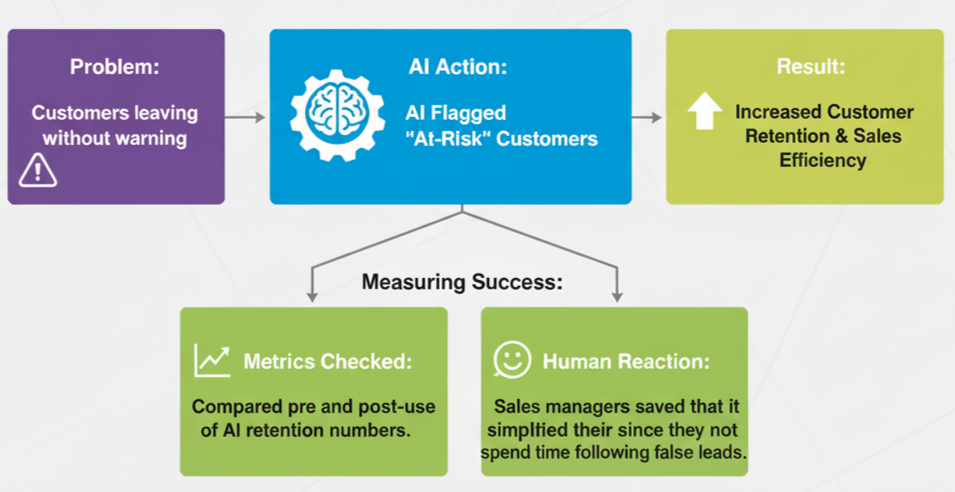
2. Banking: Catching Fraud in Real Time
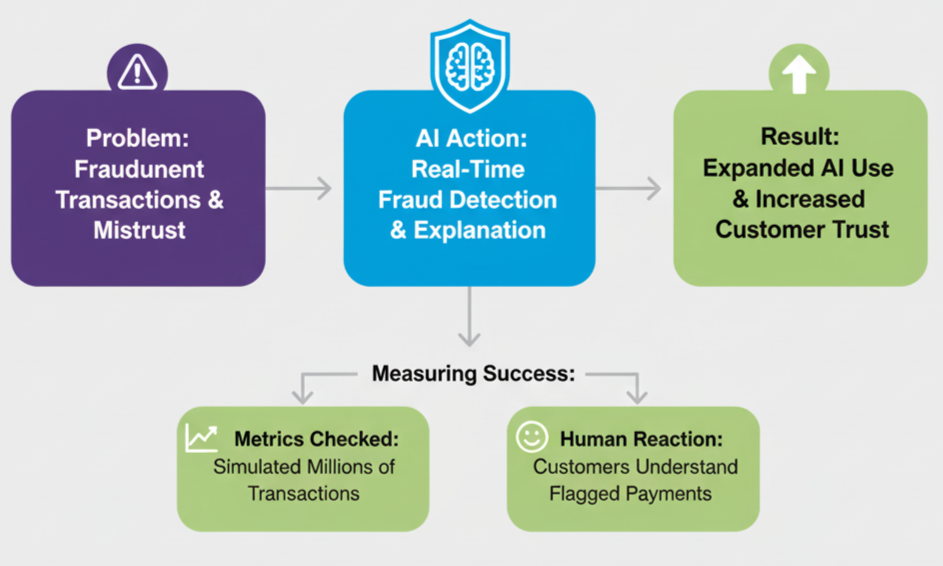
3. Logistics: Smarter Delivery Routes
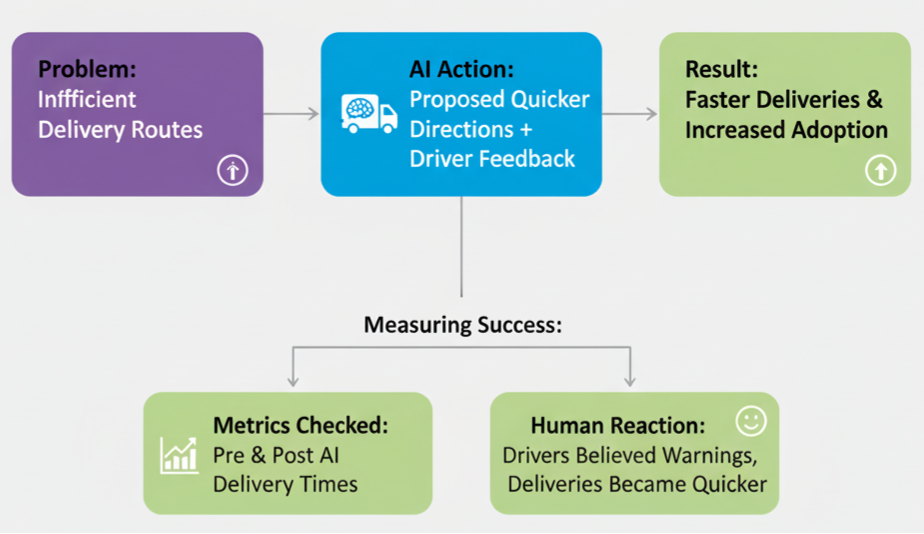
4. Manufacturing: Preventing Machine Breakdowns
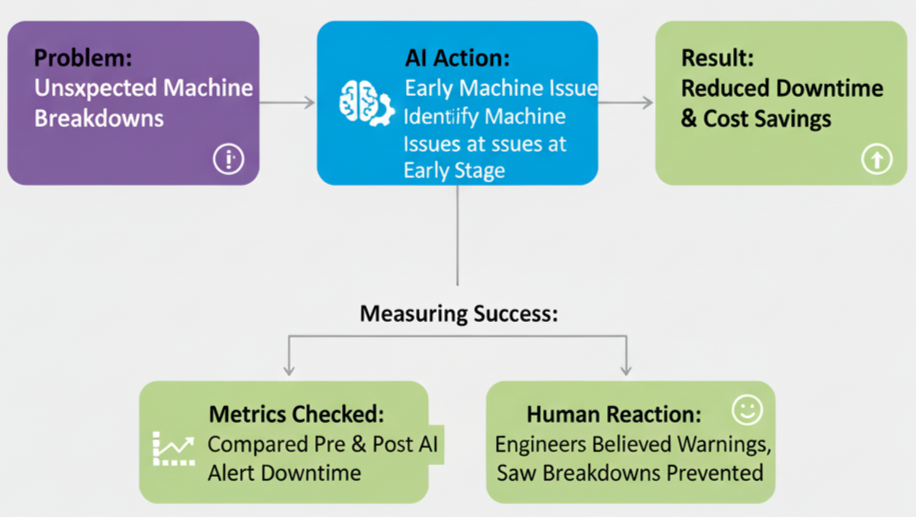
5. Healthcare: Saving Doctors' Time
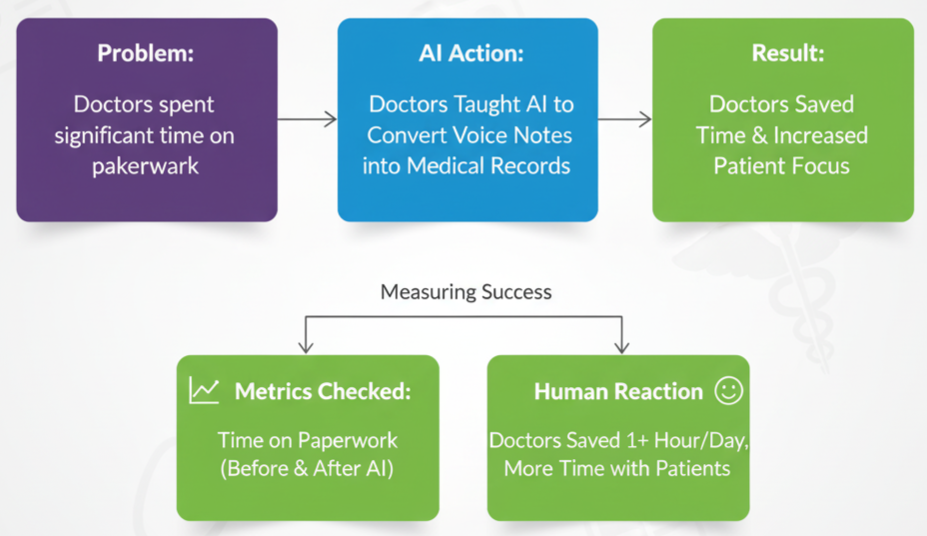
Common Challenges in Scaling AI
It is not merely about technology when scaling AI. Procedures and individuals are also important. Some common hurdles include:
- Handling scale: Can the system process millions of records reliably?
- Data security & compliance: Does it comply with legislation such as GDPR or HIPAA?
- Trust & clarity: Does AI justify a decision?
- Team adoption: Do the employees consider AI a tool of support and not danger?
👉 Example: A shipping firm noticed drivers who opposed AI pathways. Their feedback was then added and adoption increased, and delivery was quicker.
Key Takeaways
- A prototype shows what’s possible.
- Production AI shows what’s valuable.
- Scaling ensures the whole organization benefits.
- Accuracy is as important as user trust, good communication, and feedback loops.
Final Thought: It is not the number of prototypes that the company builds that makes it the real winner of AI. They transform a working idea into a consistent system that the business applies, making a real difference in performance, cost reduction, and customer satisfaction.
Ready to scale your AI projects beyond prototypes? Ellocent Labs’ expert team can help your enterprise deploy dependable AI solutions that generate real value. Contact us today to start your AI transformation journey.

The requirements under Agile development will not be any different, but when. This will either turn into a nightmare or a chance of the designers of the UI/UX. It lies in the structure of the design process. The product will not be shaky, inconveniencing, and difficult to modify even though the requirements are to be changed as it is planned by a well-planned UI/UX.
Shaping a Reusable Foundation
In Agile as a UI/UX designer, one of the most intelligent things I would do will be to develop default design items, which will be uniform throughout the product. These reusable units which are buttons, input fields, modals, and patterns of navigation are the DNA of the design system.
- They are also useful in time savings as they do not need to rework each time they start off on a sprint.
- They offer a visual homogeneity of the product.
- They make the task of the developers easier because they would not be required to go through the new design repeatedly.
And consider it to be the creation of a design language, which never loses its grammar, but gains it.
Paper to Prototype Drafting Process
In Agile, speed matters. That is why it is better to start with rough drafts and plunge into tools.

Step 1: Paper and pencil, Plus Raw and unrefined test of user flows and positioning of constituents.
Step 2: Low-fidelity wireframes: Finding meaning without thinking of design.
Step 3: Illustrate drafts in working interfaces with the help of Figma prototyping.
It implies that this stratified design suggests that the designs will be tested during the early phases and will be enhanced later during the extensive rework costs will be saved in the long-term.
Case in Point: Ellomed
In the case of Ellomed (a system of Electronic Health Records), the project was originally created with a straightforward concept of managing the physicians, clinics, and appointments. However, according to Agile, the requirements continued to be updated, such as pharmacy integration, patient documents, inventory management, etc.
UI/UX coordination helped in keeping the system on track; it did so in the following manner:
- Reusable Components: We specified the standard fields, dashboard cards, buttons, alerts, etc. They did not improve on their components by reusing them when introducing new features. This enhanced the integration as well as productivity of the UI.
- Stability Over Adaptability: The evolving needs did not bring about the destruction of the already existing module but how to insert the other modules and not to completely break down the existing one.
- A good disposition to the user: The designs were all tested on a real user need basis. A case in point is in the pharmacy module where the date of drugs was automatically highlighted in red where it had expired. It was not all that was related to the aesthetic element, but simplifying and accelerating working processes.
Concisely, the need to start afresh was not the foundation of the sound basis of design adaptability.
Ideas of Agile Best Practices of UI/UX Designers
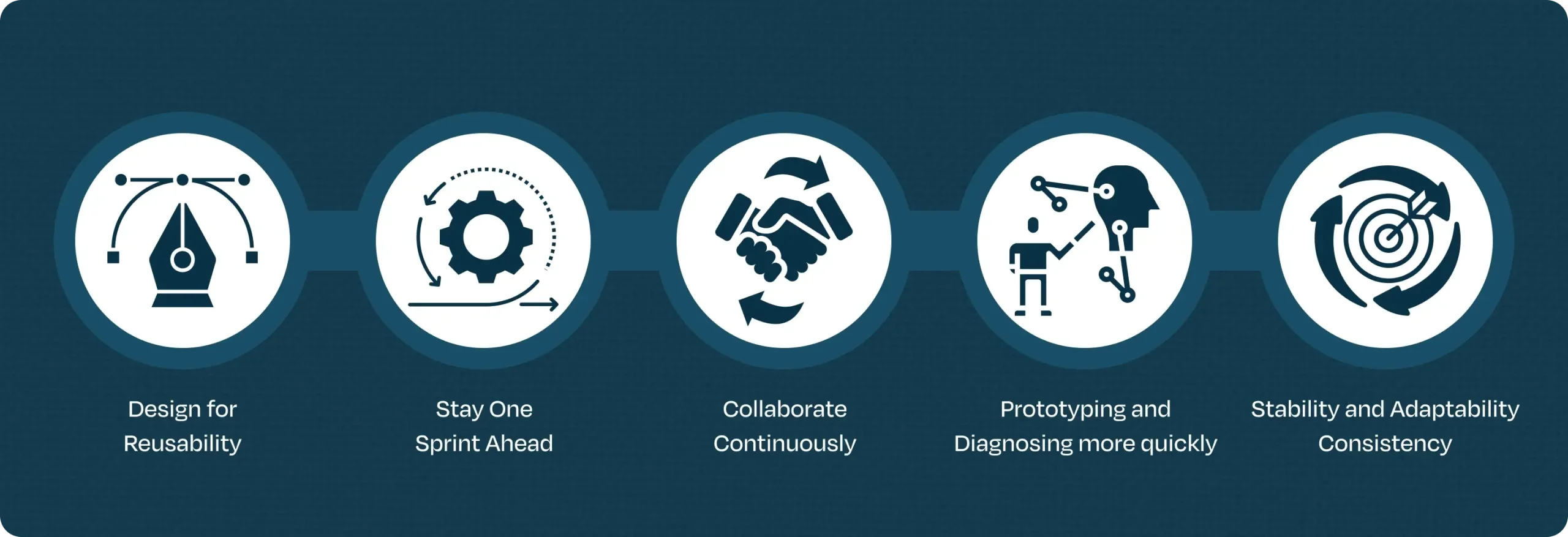
- Design for Reusability: Early analysis of component library. Imagine it to be your LEGO box, you can do anything with it, but the pieces are the same.
- Stay One Sprint Ahead: Plan the next sprint as the current one being developed. This will make sure that it is not rushed.
- Collaborate Continuously: Keep up with BAs, developing and testing. Five minutes talk will save five days of re-work.
- Prototyping and Diagnosing more quickly: The correct moment will never be to wait, to get feedback regarding drafts, and to click prototypes whenever it is possible.
- Stability and Adaptability Consistency: These design principles must be accommodated to cater to the new needs in a non-imposing manner.
Conclusion
Agile does not require the presence of UI/UX coordination in order to make interfaces appealing. It is concerning the way of developing systems that could fit the change and still remain themselves. The designers are able to cope with the challenges that occur due to change of requirements, which they could center on reusable components, draft-first design, and constant teamwork, hence, transform it into an opportunity, rather than a failure.
Practical experience with enterprises indicated that structured UI/UX causes agility to become a natural process – and the final result is not only an efficient system, but also a stable and easy to use system, coupled with being able to survive into the future.
Transform your UI/UX collaboration with Agile best practices. Ellocent Labs offers tailored workshops and hands-on support. Get started now for more efficient, adaptable interfaces.

Ellocent Labs Recognized Among Top Enterprise Software Development Companies by Techreviewer.co
Ellocent Labs IT has been honored by Techreviewer.co as one of the Top Enterprise Software Development Companies for 2026. As a forward-thinking enterprise software development company, Ellocent Labs brings together AI/ML innovation, cloud-native architecture, and custom automation and advanced mobile app development to help businesses build scalable, future-ready digital platforms.
Engineering Intelligent, Scalable Software for the Enterprise
Founded initially as Smartwiz and rebranded in 2019, Ellocent Labs, headquartered in Mohali, India, with expanding global presence in Australia and Canada, has grown into a global technology partner known for delivering cutting-edge custom software solutions.
Their mission is to deliver intelligent, scalable, and future-ready solutions – combining deep technical know-how with rapid execution to help enterprises modernize their operations and leverage AI-driven transformation.
Core Competencies & Services
Ellocent Labs offers a robust portfolio of enterprise-level services designed to meet complex, tech-driven business needs:
-
AI & Machine Learning-Powered Development – building predictive, intelligent systems that enhance decision-making and workflow automation.
-
Mobile App Development – Innovative, user-centric apps for multiple platforms, designed for engagement and ease of use
-
Custom Enterprise Solutions – end-to-end development of web and mobile applications tailored to specific business models and growth strategies.
-
Cloud & DevOps Services – scalable and reliable infrastructure design to support modern, distributed enterprise applications.
-
No-Code/Low-Code Platforms – empowering non-technical users to build internal apps and automate processes without heavy reliance on IT teams.
-
Project Management & Consulting – aligning technology initiatives with business goals through strategy, planning, and long-term partnership.
Introducing Ellomed
To further innovate healthcare technology, Ellocent Labs proudly presents Ellomed, a next-generation AI-powered healthcare platform designed to revolutionize patient care and operational efficiency across medical institutions.
Commitment to Innovation & Client Success
Ellocent Labs emphasizes ethical and responsible AI deployment, ensuring solutions are designed with integrity, trust, and sustainability. Their combination of AI, automation, mobile innovation, and custom software engineering establishes them as a compelling choice for modernization and scale.
Why This Recognition is Important
This inclusion on Techreviewer.co’s list underscores Ellocent Labs’ ability to deliver enterprise-grade systems that are reliable, innovative, and aligned with clients’ operational goals. Their expanding footprint in Australia and Canada highlights their global capability and commitment to exceptional quality across industries, including healthcare, fintech, SaaS, and more.
Looking Forward: Growth and Strategic Focus
As they move into 2026 and beyond, Ellocent Labs is focused on:
-
Enhancing their AI/ML capabilities to deliver even more advanced, predictive, and autonomous enterprise applications.
-
Scaling their cloud-native architecture to support globally distributed systems and high-availability platforms.
-
Expanding partnerships in new markets and increasing their capacity for embedded, long-term engineering engagements.
-
Strengthening their advisory and product strategy services to help clients define and execute their digital roadmaps.
-
Accelerating mobile app innovation to meet evolving consumer and enterprise demands.
-
Deepening agile and DevOps practices to deliver faster, more reliable software releases.
About Techreviewer.co
Techreviewer.co is a globally respected research and analytics platform that identifies and ranks software development firms based on expertise, client reviews, project success, and market impact. Their annual lists are a trusted resource for organizations seeking reliable, high-performing technology partners.

Web Development in 2025: AI, Web3, and Platform Shift
Modern web development faces swift changes due to the formation of new technological developments. The upcoming year of 2025 will transform the industry through three essential developments consisting of AI advancement and Web3’s expansion as well as platform-based development. Our examination will proceed through these three major predictions that are reshaping development situations for organizations and their developers.
1. The Surge in AI-Powered Applications
Web development experiences its most critical transformation through Artificial Intelligence because this innovative technology has surpassed buzzword status to become an essential development component. The new generation of AI tools delivers applications that provide stronger functionality through personalized interfaces and automated procedures. Key developments include:
- Online companies utilize AI-powered chatbots as virtual assistants, which provide smooth support for customers while improving their interactions.
- AI-based predictive analytics enables organizations to study user behaviors, which drives recommendation solutions to individual customers.
- UX designers and developers can create AI-driven applications successfully through no-code platforms that need minimal coding.
Developers must maintain competitive value through their understanding of AI frameworks and particularly TensorFlow and OpenAI API platforms.
2. The Expansion of Web3 Technologies
Web3 is revolutionizing how we interact with the web by emphasizing decentralization, blockchain integration, and user control. Major advancements to watch include:
- People access secure, decentralized applications that operate on blockchain networks through their increased levels of transparency and security.
- Smart Contracts: Automating agreements and transactions without intermediaries.
- Modern digital asset possession and client ownership via NFTs alongside tokenized products transform business content ownership and generate business revenue streams.
All developers now need to master blockchain technologies, including Solidity, or should understand the Ethereum and Polkadot platforms.
3. The Shift Toward Platform-Centric Development
Businesses need seamless operations, prompting the creation of unified platform-based ecosystems that integrate various services.
- Headless CMS: A headless CMS provides organizations with content management independence from frontend delivery systems that create improved operational flexibility.
- Microservices Architecture: Building modular, scalable applications for specific functionalities.
- Cross-Platform Development: Organizations build user-consistent platforms through the implementation of development technologies such as Flutter and React Native.
These methods help organizations construct solid, interconnected systems that fulfill different user requirements.

Preparing for the Future of Web Development
To thrive in 2025, developers and businesses should:
- Your organization should dedicate itself to continuing to learn about current and emerging technology and framework developments.
- Businesses need to merge their efforts with designers and marketers along with data scientists to generate complete solutions for their projects.
- Preventive security measures should become paramount because cyber threats are expected to escalate, so focus on developing applications that are both secure and reliable.
Final Thoughts
The future of web development remains dynamic because it possesses numerous available opportunities for advancement. Companies and developers who use AI along with Web3, along with platform-focused approaches, will lead the market. Ellocent Labs dedicates itself to leading clients through digital evolution to achieve transformative results in the digital era.
Contact us today to discuss how we can help you achieve your web development goals.

Scaling AI in Enterprises: From Prototype to Production in 2026
AI projects can be small. We generate an idea in a team. Can we predict customer churn? Can we detect fraud? Can we improve delivery routes? We built a quick prototype (proof-of-concept) that shows promise.
But the real challenge is not building that first model. The real issue is to make it something dependable, trusted, and used every day throughout the entire organization. It is on the path between idea and production at scale that the real worth of AI opens up.
From Idea to Real Business Value
A prototype will only demonstrate what can be done. Production AI proves what’s valuable. To move forward, organizations must show that the system can help in real-world use cases.
Take a retail company. Their prototype AI identified customers to target based on their purchase history. Precision was fine, but managers inquired: “So is this actually helping us to save customers?” In order to determine, the AI was connected to their CRM, thereby enabling their sales teams to receive real-time notifications. In the near future, there was an increase in the number of reps who targeted the right customers and retention.
👉 Lesson: It does not matter how accurate you are. When connected to the day-to-day business operations, value will ensue when AI is involved.
Real-World Scenarios of Scaling AI
Here’s how different industries moved from prototypes to production systems:
1. Retail: Keeping Customers from Leaving

2. Banking: Catching Fraud in Real Time

3. Logistics: Smarter Delivery Routes

4. Manufacturing: Preventing Machine Breakdowns

5. Healthcare: Saving Doctors' Time

Common Challenges in Scaling AI
It is not merely about technology when scaling AI. Procedures and individuals are also important. Some common hurdles include:
- Handling scale: Can the system process millions of records reliably?
- Data security & compliance: Does it comply with legislation such as GDPR or HIPAA?
- Trust & clarity: Does AI justify a decision?
- Team adoption: Do the employees consider AI a tool of support and not danger?
👉 Example: A shipping firm noticed drivers who opposed AI pathways. Their feedback was then added and adoption increased, and delivery was quicker.
Key Takeaways
- A prototype shows what’s possible.
- Production AI shows what’s valuable.
- Scaling ensures the whole organization benefits.
- Accuracy is as important as user trust, good communication, and feedback loops.
Final Thought: It is not the number of prototypes that the company builds that makes it the real winner of AI. They transform a working idea into a consistent system that the business applies, making a real difference in performance, cost reduction, and customer satisfaction.
Ready to scale your AI projects beyond prototypes? Ellocent Labs’ expert team can help your enterprise deploy dependable AI solutions that generate real value. Contact us today to start your AI transformation journey.

Agile UI/UX Coordination: Roles, Responsibilities and Best Practices
The requirements under Agile development will not be any different, but when. This will either turn into a nightmare or a chance of the designers of the UI/UX. It lies in the structure of the design process. The product will not be shaky, inconveniencing, and difficult to modify even though the requirements are to be changed as it is planned by a well-planned UI/UX.
Shaping a Reusable Foundation
In Agile as a UI/UX designer, one of the most intelligent things I would do will be to develop default design items, which will be uniform throughout the product. These reusable units which are buttons, input fields, modals, and patterns of navigation are the DNA of the design system.
- They are also useful in time savings as they do not need to rework each time they start off on a sprint.
- They offer a visual homogeneity of the product.
- They make the task of the developers easier because they would not be required to go through the new design repeatedly.
And consider it to be the creation of a design language, which never loses its grammar, but gains it.
Paper to Prototype Drafting Process
In Agile, speed matters. That is why it is better to start with rough drafts and plunge into tools.

Step 1: Paper and pencil, Plus Raw and unrefined test of user flows and positioning of constituents.
Step 2: Low-fidelity wireframes: Finding meaning without thinking of design.
Step 3: Illustrate drafts in working interfaces with the help of Figma prototyping.
It implies that this stratified design suggests that the designs will be tested during the early phases and will be enhanced later during the extensive rework costs will be saved in the long-term.
Case in Point: Ellomed
In the case of Ellomed (a system of Electronic Health Records), the project was originally created with a straightforward concept of managing the physicians, clinics, and appointments. However, according to Agile, the requirements continued to be updated, such as pharmacy integration, patient documents, inventory management, etc.
UI/UX coordination helped in keeping the system on track; it did so in the following manner:
- Reusable Components: We specified the standard fields, dashboard cards, buttons, alerts, etc. They did not improve on their components by reusing them when introducing new features. This enhanced the integration as well as productivity of the UI.
- Stability Over Adaptability: The evolving needs did not bring about the destruction of the already existing module but how to insert the other modules and not to completely break down the existing one.
- A good disposition to the user: The designs were all tested on a real user need basis. A case in point is in the pharmacy module where the date of drugs was automatically highlighted in red where it had expired. It was not all that was related to the aesthetic element, but simplifying and accelerating working processes.
Concisely, the need to start afresh was not the foundation of the sound basis of design adaptability.
Ideas of Agile Best Practices of UI/UX Designers

- Design for Reusability: Early analysis of component library. Imagine it to be your LEGO box, you can do anything with it, but the pieces are the same.
- Stay One Sprint Ahead: Plan the next sprint as the current one being developed. This will make sure that it is not rushed.
- Collaborate Continuously: Keep up with BAs, developing and testing. Five minutes talk will save five days of re-work.
- Prototyping and Diagnosing more quickly: The correct moment will never be to wait, to get feedback regarding drafts, and to click prototypes whenever it is possible.
- Stability and Adaptability Consistency: These design principles must be accommodated to cater to the new needs in a non-imposing manner.
Conclusion
Agile does not require the presence of UI/UX coordination in order to make interfaces appealing. It is concerning the way of developing systems that could fit the change and still remain themselves. The designers are able to cope with the challenges that occur due to change of requirements, which they could center on reusable components, draft-first design, and constant teamwork, hence, transform it into an opportunity, rather than a failure.
Practical experience with enterprises indicated that structured UI/UX causes agility to become a natural process – and the final result is not only an efficient system, but also a stable and easy to use system, coupled with being able to survive into the future.
Transform your UI/UX collaboration with Agile best practices. Ellocent Labs offers tailored workshops and hands-on support. Get started now for more efficient, adaptable interfaces.

Scaling AI in Enterprises: From Prototype to Production in 2026
AI projects can be small. We generate an idea in a team. Can we predict customer churn? Can we detect fraud? Can we improve delivery routes? We built a quick prototype (proof-of-concept) that shows promise.
But the real challenge is not building that first model. The real issue is to make it something dependable, trusted, and used every day throughout the entire organization. It is on the path between idea and production at scale that the real worth of AI opens up.
From Idea to Real Business Value
A prototype will only demonstrate what can be done. Production AI proves what’s valuable. To move forward, organizations must show that the system can help in real-world use cases.
Take a retail company. Their prototype AI identified customers to target based on their purchase history. Precision was fine, but managers inquired: “So is this actually helping us to save customers?” In order to determine, the AI was connected to their CRM, thereby enabling their sales teams to receive real-time notifications. In the near future, there was an increase in the number of reps who targeted the right customers and retention.
👉 Lesson: It does not matter how accurate you are. When connected to the day-to-day business operations, value will ensue when AI is involved.
Real-World Scenarios of Scaling AI
Here’s how different industries moved from prototypes to production systems:
1. Retail: Keeping Customers from Leaving

2. Banking: Catching Fraud in Real Time

3. Logistics: Smarter Delivery Routes

4. Manufacturing: Preventing Machine Breakdowns

5. Healthcare: Saving Doctors' Time

Common Challenges in Scaling AI
It is not merely about technology when scaling AI. Procedures and individuals are also important. Some common hurdles include:
- Handling scale: Can the system process millions of records reliably?
- Data security & compliance: Does it comply with legislation such as GDPR or HIPAA?
- Trust & clarity: Does AI justify a decision?
- Team adoption: Do the employees consider AI a tool of support and not danger?
👉 Example: A shipping firm noticed drivers who opposed AI pathways. Their feedback was then added and adoption increased, and delivery was quicker.
Key Takeaways
- A prototype shows what’s possible.
- Production AI shows what’s valuable.
- Scaling ensures the whole organization benefits.
- Accuracy is as important as user trust, good communication, and feedback loops.
Final Thought: It is not the number of prototypes that the company builds that makes it the real winner of AI. They transform a working idea into a consistent system that the business applies, making a real difference in performance, cost reduction, and customer satisfaction.
Ready to scale your AI projects beyond prototypes? Ellocent Labs’ expert team can help your enterprise deploy dependable AI solutions that generate real value. Contact us today to start your AI transformation journey.
Schedule a 15-Minutes call
Let’s make things happen and take the first step toward success!
Got Ideas? We’ve Got The Skills.
Let’s Team Up!
Let’s Team Up!
What Happens Next?
We review your request, contact you, and sign an NDA for confidentiality.
We analyze your needs and create a project proposal with scope, team, time, and cost details.
We schedule a meeting to discuss the offer and finalize the details.
The contract is signed, and we start working on your project immediately.
